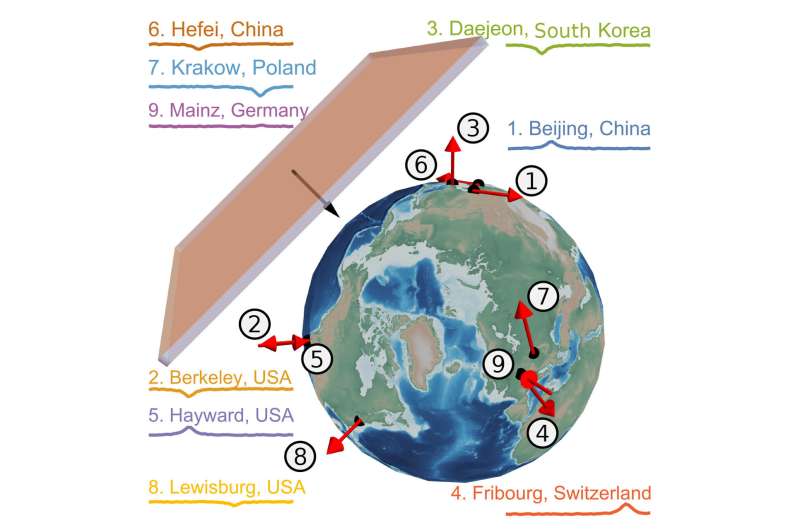A major international team of analysts with key contribution from the PRISMA+Cluster of Excellence at Johannes Gutenberg College or university Mainz (JGU) and the Helmholtz Start Mainz (HIM) has published for the first time complete data on the search for black matter by using a worldwide network of optical magnetometers. According to the scientists, black matter fields should produce an attribute signal pattern that can be diagnosed by correlated sizes at multiple areas of the DON network. Analysis of information from a one-month continuous DON functioning hasn't yet yielded a matching indication. Yet, the measurement allows the formulation of limitations on the functions of dark matter, as the researchers review in the log Nature Physics.
 |
| Sketch of the worldwide GNOME network. Credit: Hector Masia Roig |
DON stands for Worldwide Network of Optic Magnetometers for Unique Physics Searches. Right behind it are magnetometers distributed all over the world inside Germany, Serbia, Biskupiec, Poland, Israel, South Korea, China, Australia, in addition to the United Declares. With the gnome, the particular researchers particularly need to advance the particular search for dark matter—one of the particular most exciting problems of fundamental physics in the twenty first century. In fact, this has long already been known that lots of perplexing astronomical observations, like the rotation speed regarding stars in galaxies or the range of the cosmic background radiation, could best be described by dark make a difference.
"Extremely light bosonic particles are viewed as a single of the many promising individuals regarding dark matter these days. These include alleged axion-like particles—ALPs regarding short, " mentioned Professor dr. Dmitry Budker, professor at PRISMA+and at HIM, a great institutional collaboration regarding Johannes Gutenberg University or college Mainz and the particular GSI Helmholtzzentrum jetzt für Schwerionen for schung in Darmstadt. "They can be regarded as a time-honored field oscillating having some frequency. Some sort of peculiarity of this sort of bosonic fields can be that—according into a attainable theoretical scenario—they can easily form patterns together with structures. As some sort of result, the thickness of dark subject could be located in many several regions—discrete domain wall surfaces less space-consuming as compared to a galaxy nonetheless much larger as compared to Earth could variety, to illustrate. "
"If this sort of wall relationships planet earth, it can be steadily detected by simply the GNOME community and can lead to transient characteristic sign patterns in typically the magnetometers, " discussed Dr. Arne Wickenbrock, one of typically the study's co-authors. "Even more, the impulses are correlated having the other using ways—depending how fast typically the wall is going and when that reaches each position. "
The community meanwhile, involves 18 magnetometers distributed above eight countries world-wide. Nine of these people provided data to get the current examination. The measurement process is based on an interaction involving dark matter having the nuclear moves of the atoms in the magnetometer. The atoms happen to be excited with some sort of laser at a certain frequency, orienting typically the nuclear spins throughout one direction. Virtually any dark matter discipline can disturb this kind of effort, which can be measurable.
Figuratively speaking, one can suppose the atoms in the magnetometer in the beginning dance around in confusion, as clarified by Hector Masia-Roig, a doctoral pupil in the Budker group and also a writer of the current examine. "When they 'hear' the right regularity of laser light, they all rewrite together. Dark make a difference particles can chuck the dancing atoms out of balance. We can calculate this perturbation very precisely. " Today the network of magnetometers becomes important: When the World moves through a spatially limited wall structure of dark make-a-difference difference; the dancing atoms in all channels are slowly disrupted. One of these stations is positioned in a laboratory at the Helmholtz Start in Mainz. "Only when we match the signals from all the channels can we examine what triggered the disturbance, "said Masia-Roig. "Applied to the image of the dancing atoms, this means: If we compare the dimension comes from all the stations, we can decide whether it was just one brave ballerina dancing out of line or actually a global darker matter disturbance. inch
In the modern study, the research team evaluates data from your one-month continuous functioning of gnome. The effect: Statistically considerable signals performed do not appear in the investigated bulk range between one femtoelectronvolt (feV) to a hundred, 000 feV. Alternatively, consequently, the research workers could narrow down the range through which such signals could theoretically be found even more than before. For cases that rely on discrete dark subject walls, this is an important result—"even though we certainly have not yet been able to find such a domain wall membrane with our global ring search, inches added Joseph Smiga, another Ph. N. student in Mainz and author of the analysis.
Future work of the DON collaboration will give attention to bettering both the magnetometers themselves and the data analysis. Throughout this particular period, continuous performance should be even more stable. This kind of is very important to reliably hunt for signals that outlive an hour. Throughout addition, the preceding alkali atoms in the magnetometers can be replaced by regal gasses. Under the title Advanced DON, the researchers expect this to cause considerably better tenderness for future size in the look for ALPs and dark matter.
